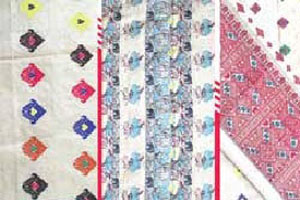
HRDC to register rich traditional textile designs of State
YarnsandFibers News Bureau 2017-12-30 11:00:00 – GuhawatiThe traditional designs of the State reflect the rich cultural and aesthetic heritage of its indigenous people. They also form a part of the ethno-history of this part of the globe with their intricacies and brilliance. To provide protection from plagiarists, the Handloom Research and Designing Centre (HRDC) have submitted proposal to the State’s Handloom Directorate to register the traditional textile designs of the State with the Design Registry of the country.
The HRDC has received assurance from the Patent Information Centre (PIC) of the Assam Science Technology and Environment Council (ASTEC) of all possible support in this connection.
The HRDC has developed thousands of designs for handloom fabrics since 1960. Of these designs, over 1,000 have been embroidered into woven cloths by the weavers of the State during the past about 50 years.
Experts believe that collection and careful preservation of these designs are of immense significance for formatting the ethno-cultural history of the people of this part of the globe.
Sources in the HRDC said that though the Centre is mostly developing designs, called the diversified ones, basing mainly on the traditional ones, the ratio of the traditional designs and the newly developed ones stands at 50:50.
However, records of the old designs it has developed are not available with the Centre due to certain problems it had to face during the past about 50 years.
At present, textile designers of the Centre are developing new designs basing either on some themes relating to current developments or some old designs. For example, rhino poaching has been taken as the theme for a new design developed by these designers. The geometrical approach of the traditional designs has also become the base for some new designs, which have the admixtures of the creepers and the geometrical shapes as their central themes.
The themes of the traditional designs were also conceptualised as the base with the particular colours that are inseparably linked with them in matters of expressing or referring to some ideas which are associated with the traditional festivities, etc. For example, if such a design is meant for a gamocha, red colour usually becomes the lone option. For, red colour has much connection with Rongali Bihu, the festival related with productivity.
Moreover, the Centre has been producing greetings cards with decorative traditional and modern fabric designs for Rongali Bihu for around 30 years.
The Textile Chemistry section of the HRDC has been making continuous efforts to preserve the traditional dyeing techniques. It is also demonstrating the natural dyeing processes in different parts of the State for the benefit of those connected with the traditional loom sector.
The section has evolved different colour shades of natural and chemical dyes. The fast-coloured yarn dyed in the section is generally used for producing different types of design.
Sources said that it has recently set up a library-cum-information cell and a testing laboratory as well. It also preserves and demonstrates different types of handlooms.
The HRDC provides free-of-cost services in installing handlooms. It also supplies designs and develops the designs as sought for by the weavers and their cooperative societies, besides imparting training on designs and dyeing. It is holding workshops too on dyeing.
Market Intelligence
Ask for free sample Report

experience
Customer Base
dedicated team
Countries Served Worldwide









